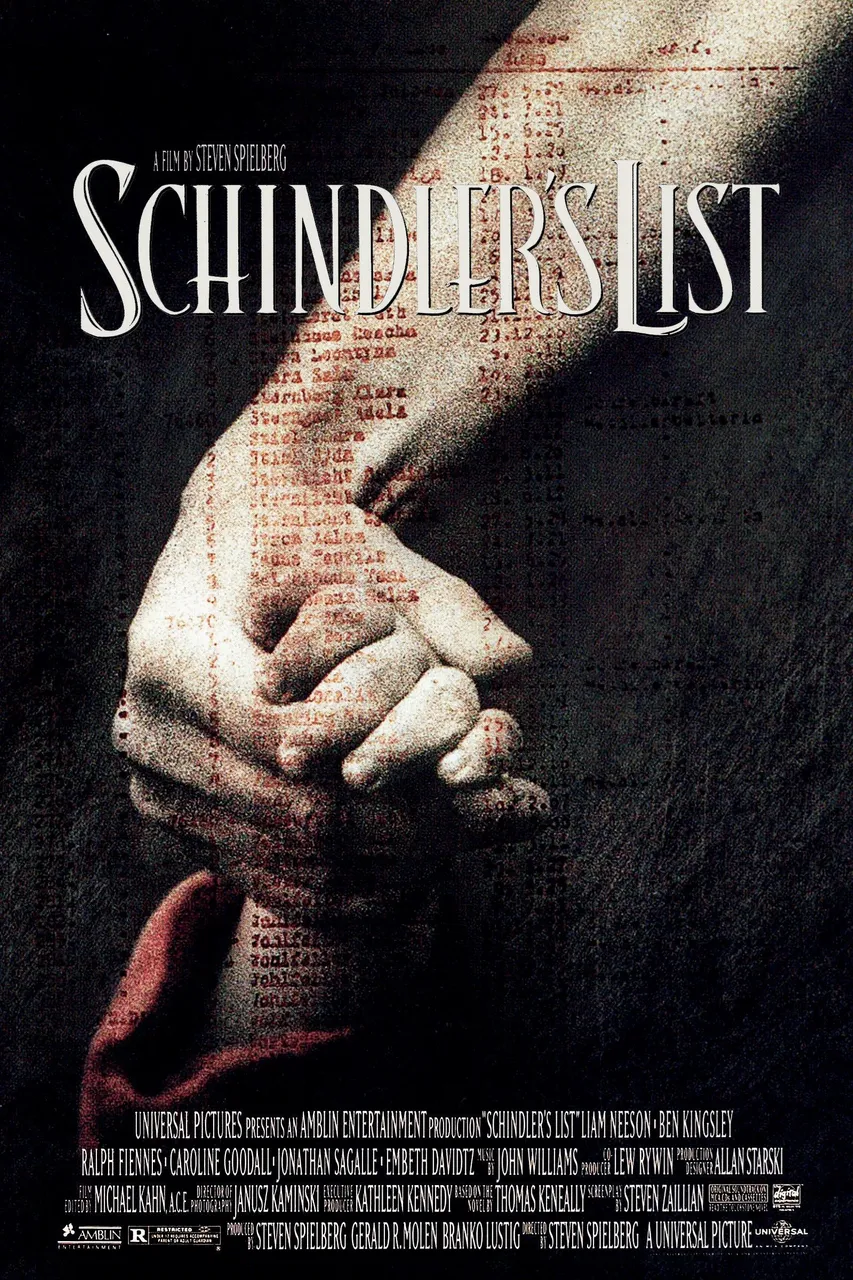
Schindler’s List is a 1993 American epic historical drama film directed and produced by Steven Spielberg and written by Steven Zaillian. The film is based on the 1982 novel "Schindler's Ark" by Australian novelist Thomas Keneally. It follows Oskar Schindler, a German industrialist who saved more than a thousand mostly Polish-Jewish refugees from the Holocaust by employing them in his factories during World War II.
The film stars Liam Neeson as Schindler, Ralph Fiennes as SS officer Amon Göth, and Ben Kingsley as Schindler's Jewish accountant Itzhak Stern. Schindler’s List premiered on November 30, 1993, in Washington, D.C., and was released on December 15, 1993, in the United States. The film received universal acclaim for its tone, acting, atmosphere, score, cinematography, and Spielberg's direction. It was also a box office success, earning $322 million worldwide on a $22 million budget.
Plot
Schindler’s List is a film that follows the story of Oskar Schindler, a German industrialist who saved more than a thousand mostly Polish-Jewish refugees from the Holocaust by employing them in his factories during World War II. The plot depicts Schindler's transformation from a greedy businessman to a savior of life. The film showcases his efforts to protect his Jewish workers from the horrors of the Holocaust, ultimately leading to the survival of those on Schindler’s List while he faces financial ruin and the threat of being labeled a war criminal.
Cast
- Liam Neeson as Oskar Schindler
- Ben Kingsley as Itzhak Stern
- Ralph Fiennes as Amon Göth
- Caroline Goodall as Emilie Schindler
- Jonathan Sagall as Poldek Pfefferberg
- Embeth Davidtz as Helen Hirsch
- Malgorzata Gebel as Wiktoria Klonowska
- Shmuel Levy as Wilek Chilowicz
- Mark Ivanir as Marcel Goldberg
- Béatrice Macola as Ingrid
- Andrzej Seweryn as Julian Scherner
- Friedrich von Thun as Rolf Czurda
- Krzysztof Luft as Herman Toffel
- Harry Nehring as Leo John
- Norbert Weisser as Albert Hujar
- Adi Nitzan as Mila Pfefferberg
- Michael Schneider as Juda Dresner
- Miri Fabian as Chaja Dresner
- Anna Mucha as Danka Dresner
- Jacek Wójcicki as Henry Rosner
- Beata Paluch as Manci Rosner
- Piotr Polk as Leo Rosner
- Bettina Kupfer as Regina Perlman
- Grzegorz Kwas as Mietek Pemper
- Kamil Krawiec as Olek Rosner
- Henryk Bista as Mr. Löwenstein
- Ezra Dagan as Rabbi Menasha Levartov
- Rami Heuberger as Joseph Bau
- Elina Löwensohn as Diana Reiter
Director: Steven Spielberg
Writer: Steven Zaillian
Box Office Gross: $322,161,245
Distributor: Universal Pictures
Genre: History, Drama
Release Date (Theaters): Dec 15, 1993
Rerelease Date (Theaters): Dec 7, 2018
Release Date (Streaming): Mar 5, 2013
Themes and Reception
Schindler’s List explores themes of life, death, and the war between good and evil. The film depicts the horrors of the Holocaust and the Nazis' attempt to exterminate the Jewish population. Despite the overwhelming evil, the Jews in the film exhibit an unbroken spirit and will to survive. The film received universal acclaim for its tone, acting, atmosphere, score, cinematography, and Spielberg's direction. It was also a box office success, earning $322 million worldwide on a $22 million budget.
Challenges Faced
The production design team had a huge role to play in creating the overall sense of feeling that audiences walk away with when leaving the movie theatre. The film was shot in black and white to create a sense of authenticity and to pay homage to the era in which the story takes place. The filmmakers also faced the challenge of depicting the horrors of the Holocaust without being exploitative or gratuitous.
Settings
The film is set in Poland during World War II, primarily in the city of Krakow and the nearby Plaszow labor camp. The filmmakers used actual locations, including the factory where Schindler employed his workers, to create a sense of realism. The film's setting and attention to historical accuracy have contributed to its impact on audiences and its critical acclaim.
Fun Fact and Trivia
- The film was shot in black and white to create a sense of authenticity and to pay homage to the era in which the story takes place.
- The most famous use of symbolic color in the film is the young girl in the red coat. The girl's coat is the only object in the film that appears in color, and it serves as a symbol of the innocence and vulnerability of the Jewish people.
- The film was a passion project for director Steven Spielberg, who had been interested in making a film about the Holocaust for many years before Schindler’s List was made.
- The film's impact on audiences and its critical acclaim has led to its inclusion in many lists of the greatest films ever made.
- The film's title refers to the list of Jewish workers that Schindler saved from the Holocaust.
Visual Styles and Techniques
- The film's visual choices, such as the use of black and white and the symbolic use of color, support the experience of the events depicted in the film.
- The filmmakers used actual locations, including the factory where Schindler employed his workers, to create a sense of realism.
- The film's cinematography, which includes many long takes and wide shots, creates a sense of space and allows the audience to take in the full horror of the events depicted.
- The film's score, composed by John Williams, is haunting and emotional, and it adds to the film's impact on audiences.
